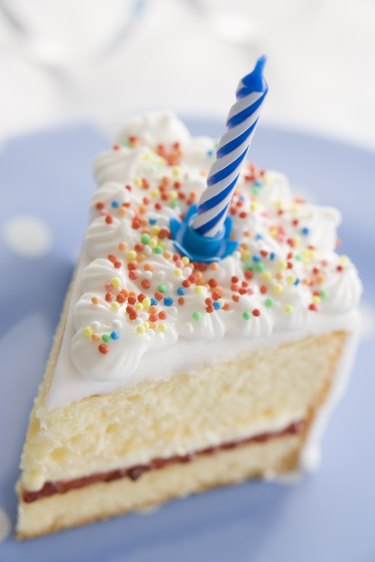
Most types of icing are very high in fat, containing either butter, shortening or margarine. Seven-minute icing, also known as boiled icing, is different. It's a light, frothy, pure-white icing that contains no fat at all, though it's still high in sugar. It was popular decades ago, and is just old-fashioned enough now to qualify for "retro-chic" status. The recipe incorporates egg whites, but can safely be held at room temperatures for a day or two.
Preparation Methods
Video of the Day
Seven-minute icing or boiled icing is essentially a well-sweetened meringue. Some versions call for the egg whites and sugar to be whipped together in a double boiler until they reach a temperature of 160 degrees Fahrenheit, while others heat the sugar separately in a syrup and then drizzle the hot syrup into the egg whites as they whip. In either case, the egg whites reach a food-safe temperature during the preparation process. If your icing won't be eaten immediately, it's prudent to gain an extra measure of food safety by using pasteurized egg whites.
Video of the Day
Using the Icing
When it's made successfully, boiled icing makes a light, snowy-white marshmallowy topping for your cakes. It's very soft and spreads easily, rather like whipped cream. use it between layers of your cakes, inside a Swiss roll, and to coat your cake thickly around the top and sides. Like the meringue on top of your lemon pie, it can easily be piped or swirled into peaks and mounds on top of the cake for an attractive appearance. It's also soft enough to hold other decorative elements such as colorful "jimmies" and sprinkles, or toasted coconut.
Storing the Icing
It's always best to use seven-minute icing as soon as it's made and cooled, when it's at its smoothest and most malleable. Still, it can be refrigerated for a day or so if necessary. Spoon the icing into an airtight container just large enough to hold it, and seal it tightly. If the icing doesn't fill the container completely, press a piece of plastic film wrap to its surface to block out any air. Otherwise, the surface of your icing will become hard. If your icing hasn't reached the correct temperature during preparation, refrigeration will make it break down and become runny. If that happens, your icing can't be salvaged.
Food Safety
It's important to use a good-quality thermometer to verify that your icing reaches the correct temperature, to ensure both a reliable icing and food safety. As long as your icing has reached a food-safe temperature during cooking, it's safe to keep your iced cake at room temperature. The high level of sugar in your icing acts as a preservative, just as it does in jams and jellies, and keeps the egg proteins from deteriorating. However, your boiled icing will begin to deflate steadily after a day or two, so it should be eaten quickly to maintain the best quality.